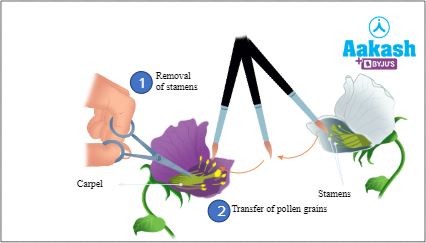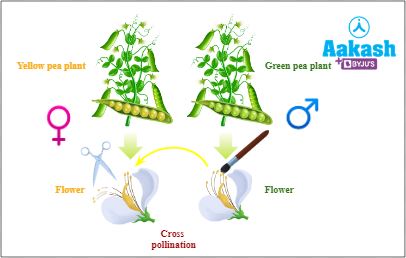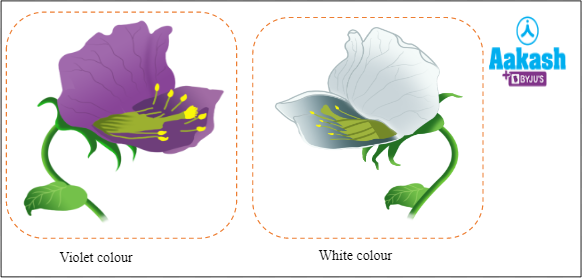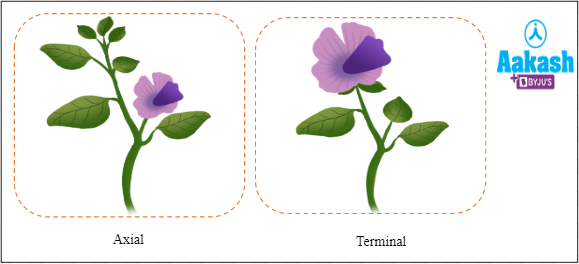-
Call Now
1800-102-2727
Law of Segregation, Law of Dominance, Monohybrid Cross, Example, Significance, Practice Problems and FAQs
Living beings produce offspring that resemble their parents. This is required to sustain life on the Earth. We came to this world through our parents. But have you ever wondered why you have some characters similar to your father and some other characters similar to your mother. Yes, this is because of heredity. Heredity is the transmission of characters from one generation to the next generation. This is done with the help of genetic material.

Fig: Heredity
Now tell me where genetic material is present in a cell. Yes, the nucleus of the cell contains the genetic material. The most condensed form of genetic material is the chromosomes which have the genes. So now we know it is genes that we inherit from our parents. This is applicable to all living beings. Every living being produces offspring that resemble their parents in certain fundamental characteristics. Genes are the physical and functional unit of heredity. Now let me ask another question. We all human beings belong to the same species but all the individuals are different except identical twins. Why is this happening? Answers to such questions were given by Mendel. Mendel proposed certain laws of inheritance. Let’s learn about these laws in detail in this article.
Table of contents
- Era of Mendel
- Experiments of Mendel
- Monohybrid cross
- Law of dominance
- Significance of law of dominance
- Drawbacks of law of dominance
- Law of segregation
- Significance of law of segregation
- Practice Problems
- FAQs
Era of Mendel
Gregor Johann Mendel was born in 1822. He is referred to as the father of genetics. Mendel proposed that heredity is controlled by factors now called genes. He said that factors are present in the cells of the body and are transmitted to the next generation through gametes. During his studies, he put forth three laws of inheritance. Mendel’s laws are known as laws of inheritance which are as follows:
- Law of dominance (First law)
- Law of segregation (Second law)
- Law of independent assortment (Third law)

Fig: Gregor Johann Mendel
Experiments of Mendel
Mendel worked on garden pea Pisum sativum between 1856 and 1863. He selected specific traits from the peas during that time and studied inheritance. Mendel considered 7 main contrasting traits in the plants for studies. He selected 14 true breeding garden pea plant varieties for his research. As seen in the table below, each of the seven types of plants had at least one character with two dissimilar traits (dominant and recessive). By enabling the plant to self-pollinate, Mendel was able to verify that each character was the result of true breeding. A true breeding or pure line is one plant that, after going through numerous generations of continual self-pollination, exhibits consistent trait inheritance and expression. Any plant that displayed a deviation was eliminated from the studies. The characters studied by Mendel are as follows:
|
Character |
Contrasting traits |
Images |
|
|
Dominant |
Recessive |
||
|
Stem height |
Tall (T) |
Dwarf (t) |
Fig: Stem height |
|
Flower colour |
Violet or red (W) |
White (w) |
Fig: Flower colour |
|
Flower position |
Axial (A) |
Terminal (a) |
Fig: Flower position |
|
Pod shape |
Inflated (I) |
Constricted (i) |
Fig: Pod shape |
|
Pod colour |
Green (G) |
Yellow (g) |
Fig: Pod colour |
|
Seed shape |
Round (R) |
Wrinkled (r) |
Fig: Seed shape |
|
Seed colour |
Yellow (Y) |
Green (y) |
Fig: Seed colour |
Procedure of the experiment
Mendel performed his experiments in three stages as follows:
- Selection of pure or true breeding parents.
- Hybridisation and obtaining F1 generation of plants.
- Self pollination of hybrid plants to raise subsequent generations like F2.
Selection of parents
Mendel selected a true breeding pea plant which produced yellow seeds and a true breeding pea plant which produced green seeds as parents.

Fig: Selection of true breeding parents
Hybridisation of F1 generation
Mendel cross pollinated plants with alternative forms of traits. He cross pollinated the flowers by dusting the stigma with pollen from the other 50% of the flowers, which he employed as male flowers by bagging their stigma. He emasculated (removed anthers) 50% of the flower of the same plant to function as female plants. The hand pollinated flowers were covered with paper bags to prevent contamination from foreign pollen grains.

Fig: Cross pollination procedure
In this experiment the yellow pea plant without the anthers would become the female plant and the green pea plant would become the male since it is the one providing the anthers. Once fertilised, the female flower will form a fruit, which is the pea pod.

Fig: Cross pollination
Mendel found that all F1 generation plants bore yellow coloured seeds just like one of its parents. None of the plants bore green coloured peas.

Fig: F1 generation
Self breeding in hybrid plants for F2 generation
Seeds obtained from self pollination of F1 were planted and progeny generation was called the second filial generation or the F2 generation. Mendel found that the F2 generation had both yellow and green coloured pea plants. The ratio of yellow to green pea plants was around 3 : 1.

Fig: F2 generation
Monohybrid cross
The cross in which the alternative forms of a single character is used is called monohybrid cross. The two plants used in this experiment have homozygous genotypes and are true breeding. So the overall experiment conducted by Mendel looks something like this. Here the yellow and green pea plant is represented by its respective pea colour.

Fig: Monohybrid cross
Mendel observed that one of the two traits disappear completely in F1 generation (for example green peas), which reappeared in F2 generation at the ratio of 3:1. Traits in progeny were not blended. There were only green and yellow peas. No lime ones. He performed monohybrid crosses to examine the inheritance of additional traits, and he achieved similar results. In contrast to the F2 generation, where both qualities (dominant and recessive) emerged in the ratio 3:1, only one of the two parental traits (dominant) was displayed in the F1 generation.
Law of dominance
Through the monohybrid cross Mendel proposed that the trait present in both F1 and F2 generation is called the dominant trait and the trait that disappears in F1 generation but appears in F2 generation is called the recessive trait. For example in case of cross between, yellow and green coloured pea plants, yellow can be called as the dominant trait since it was present in both F1 and F2 generations. While green is a recessive trait since it was absent in F1 generation but reappeared in F2 generation.
Law of dominance states that when two alternative factors or genes come together in an organism, only one of them called recessive remains unexpressed. Allele responsible for yellow colour pea (Y) was dominant over allele responsible for green colour pea (y). Hence, all the heterozygous Yy progeny of F1 were yellow in colour. Allele for green colour was recessive and hence it was seen only in F2 generation when both the alleles were of yy genotype.




GIF: Green peas recessive to yellow peas
Significance of law of dominance
The following are the significance of the law of dominance:
- The new combinations in the progeny of hybrids can be predicted.
- The frequency of new combinations can be predicted.
- Plant and animal breeders can use it to produce good breeds.
Drawbacks of law of dominance
- Dominance does not always occur in every pair of contrasting characters.
- Not all characters are controlled by a single pair of contrasting alleles. For example, multiple allelism shown by ABO blood group.
- Sometimes, in a pair of contrasting alleles neither one is dominant, and both the alleles express themselves resulting in an intermediate phenotype. Thus a blending of traits is seen. This is known as incomplete dominance. Examples include the flower colour in Antirrhinum majus (snapdragon).

Fig: Incomplete dominance in Antirrhinum majus (snapdragon)
- Co-dominance of alleles is seen in many cases in which both the alleles expressed equally and both the phenotypes of the individual alleles are observed. Examples include coat colour in cows.

Fig: Coat colour in cows
Law of segregation
Each parent contributes one copy of a trait to offspring. The type of trait copies received will decide the overall appearance of offspring. The law of segregation is the second law of inheritance. It is also called the purity of gametes. It states that ‘during gamete formation, pairs of alleles segregate such that each gamete receives only one allele’.
Or
“The two alternative factors or alleles of a pair representing a character are separated from each other at the time of gamete formation so that a gamete contains only one factor for the character and the paired condition is restored by the random fusion of gametes during fertilisation.”
Mendel proposed this law on the basis of observation that no blending or mixing of alleles occurs in any progeny. Despite the fact that the parents have two alleles, the alleles segregate during gamete production, and each gamete inherits just one of the two alleles. Hence a gamete is always pure for that character. The two alleles of a pair occur with equal frequency in the male and female gametes. The separated factors are randomly united in pairs through male and female gametes during fertilisation and transferred to the progeny. A homozygous parent generates identical gametes, whereas a heterozygous parent creates two types of gametes, each with an equal quantity of one allele as represented below.

Fig: Gamete formation
Let’s see one example of a monohybrid cross showing the law of segregation where a heterozygous tall (Tt) pea plant is crossed with a short pea plant (tt).

Fig: A monohybrid cross showing the law of segregation
Significance of law of segregation
The significance of the law of segregation are as follows:
- We can comprehend the pattern of single-gene inheritance because of the law of segregation.
- It reveals how traits are transmitted from one generation (parent) to the following generation (offspring).
- It aids in comprehending the separation of pairs of gene variants into reproductive cells.
Practice Problems
1. Which traits of pea seed colour did Mendel observed in the F2 offspring on crossing true-breeding yellow-seeded and true-breeding green-seeded parent plants?
- Only green seeds
- Only yellow seeds.
- 1 (yellow seed) : 1 (green seed)
- 1 (green seeds) : 3 (yellow seeds)
Solution: Cross pollination of true breeding plants was performed by Mendel. He performed the cross between true breeding yellow pea plant and true breeding green pea plant. The seeds produced by the cross of gametes from the parental generation produced the first hybrid plants called the first filial progeny or F1 generation. 100% of the F1 generation expressed the trait of one of the parents in a monohybrid cross (all yellow). Self-pollination of the plant of the F1 generation produced plants of the F2 generation. F2 generation showed the presence of both the contrasting traits in the phenotype corresponding to the ratio of 3 (yellow) :1 (green) in a monohybrid cross. Hence the correct option is d.

Fig: Monohybrid cross
2. At which stage does segregation of alleles take place?
- During mitosis
- During meiosis
- During fertilisation
- During embryo formation
Solution: The law of segregation states that each factor in a pair separates during gamete formation, such that each gamete receives only one allele of a character. Gamete formation happens by the process of meiosis. Hence the correct option is b.
3. Identify the odd ones out with respect to Mendel’s chosen characters for experiments on garden pea plants.
- Flower colour, plant height and pod size
- Leaf position and pod size
- Flower position, leaf position and seed colour
- Leaf position
Solution: One of the reasons Mendel selected the pea plant for his experiments was the presence of a number of visible characters with contrasting traits. He was very interested in creating hybrids of the plants with these characters. Seven characters selected by Mendel are as follows:
- Seed shape
- Seed colour
- Pod shape
- Pod colour
- Flower colour
- Flower position
- Stem height
Thus, in the list given, odd ones are leaf position and pod size. Hence the correct option is d.
4. When a true breeding pea plant that produces green seeds is pollinated by a true breeding pea plant that produces yellow seeds, all the F1 plants have yellow seeds. This means that the allele for yellow is ______________.
- heterozygous
- dominant
- recessive
- lethal
Solution: Yellow and green seeds are the phenotypic characters shown by pea plants. On taking consideration of the law of dominance, it can be stated that if yellow colour seeds are found in all plants of F1 generation which shows that yellow seed allele is dominant over green seed allele. Dominant expression of any allele can be easily seen in heterozygous plants whereas recessive genes can express only in homozygous conditions.




GIF: Green peas recessive to yellow peas
FAQs
1. What is a true breeding plant?
Answer: A true breeding plant is one that has undergone self-pollination generation after generation and has stable trait inheritance. It produces plants that are genetically identical for the specified traits. It can not be obtained by cross-pollination.
2. Which law of Mendel is the universally accepted law of inheritance?
Answer: The universally accepted law of inheritance is the law of segregation. It is the only law in existence that is absolute and without any exception. It states that “the two alternative factors or alleles of a pair representing a character are separated from each other at the time of gamete formation so that a gamete contains only one factor for the character and the paired condition is restored by the random fusion of gametes during fertilisation.”
3. Why does Mendel use pea plants as the experimental tool?
Answer: Mendel used pea plant as the tool for his experiment because of the following reasons:
- A large number of true breeding varieties with observable alternative forms for a trait or characters were available.
- Pea plants can be self fertilised.
- Pea plants can be cross fertilised.
- It is an annual plant and gives results within a year.
- A large number of seeds are produced by the pea plants.
- These plants can be easily cultivated.
- Drawing results from pea plants and maintaining data is easy.
- Plants do not require much care.

Fig: Pea plant
4. What are the concepts covered in the law of segregation?
Answer: There are four ideas that make up the law of segregation. These are listed below:
- Alleles are the general term for the various forms that a gene might make.
- For each trait, an organism inherits two alleles.
- Single alleles can be separated at the time of gamete formation.
- There are two categories of distinct alleles such as dominant and recessive.










